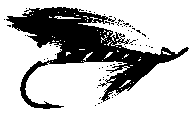
Atlantic Salmon FAQ- Flies and fly selection
Contributed by Bob Boudreau (copyright)
e-mail: salmon@atcon.com
Unlike trout, the Atlantic Salmon does not feed after it enters fresh water.
Trout flies generally imitate a trout's food source which is not the case
for salmon. It is quite obvious that when trout are feeding on ants, fishing
an ant pattern should prove successful if the fly is presented properly.
When the fish are not feeding on the surface you are able to analyze,
through various methods, the probable food sources and you can narrow you
fly selection to a few different patterns. Salmon anglers do not enjoy the
benefit of this logical approach to fly selection. Fly selection for salmon
is primarily a learned art with some guiding principles. Patterns can be
river, region and/or season specific. A pattern that works well under one
set of conditions, may not be productive under others. Variables include
water depth, speed, color, temperatures, brightness of day, time of year,
how long fish have been in the river etc. Local knowledge from fellow
anglers, guides and fisheries officers is invaluable.
There are many theories as to why salmon will take a fly, although no one
knows for sure. The theories include:
- anger
- agitation
- links to earlier feeding patterns as a parr in the river or as smolt/salmon at sea
- territorial instinct
- playing (occasionally salmon will rise and bump a dry fly with their nose).
It is still a mystery why, after hundreds of casts and dozens of flies, a
salmon decides to take the next fly.
There are thousands of fly patterns used to fish for the Atlantic Salmon.
Some flies have been proven on numerous rivers and throughout the world
while others are river specific in terms of their effectiveness.
Below is a limited selection of patterns and sizes that have become popular
in Atlantic Canada.
DRY FLIES
Bomber Series - sizes 2,4, 6, 8 on 1X to 3X long hooks
Colors - natural, white, brown, green and orange bodies with various colors
of hackle e.g. orange, brown, grizzly etc.
Bug Series - sizes 4,6,8,10
Colors - natural, white, brown, green and orange bodies with various colors
of hackle e.g. orange, brown, grizzly etc.
Wulff Series - sizes 2,4,6
Colors - white, grey etc.
Cosseboom (dry) - sizes 2,4,6, 8
MacIntosh - sizes 2,4,6, 8
WET FLIES
Spring/Summer
- Butterfly Series
- Black Bear Series
- Green Machine
- Silver Doctor
- Buck Bugs
- Blue Charm
- Rat Series
- Cosseboom Series
- Green Highlander
- Ross Special
- Mickey Finn
Sizes for the above are 2,4,6 with 8,10,12 for low water conditions.
Fall
Although most of the summer wet flies are also effective in the fall, the
following flies are most effective for late run fish.
- General Practitioner
- Mickey Finn
- Cardinelle
- Bucktail Streamer Series
Sizes for the above are 2/0 to 6
Note: In Atlantic Canada fishing for Atlantic Salmon is regulated to
flyfishing only with unweighted flies having not more than 2 hooks
(single hooks only in Newfoundland).
The detailed fly tying patterns for the above referenced flies can be found
in numerous books and magazines as well as various sites
on the World Wide Web. Dave Liverman has a
collection of Newfoundland patterns
archived by Martin Erikson, on whose site you will also find some
information on salmon fishing in Sweden.
Fly Selection
Guiding Principles/Rules of Thumb -
- Bright flies for a bright day and dark flies for a dark day.
- Dark fly for dark water and bright fly for clear water.
- Dark flies or very bright flies for dirty water (runoff or flood conditions).
- Large flies for high water and small, lightly dressed flies for low water.
- Water temperature over 60 degrees, salmon have greater tendency to take dry
flies.
- Fall flies are traditionally larger and more colorful.
- If you are unsure about fly size, start with a # 6 for wet flies. Change
to a smaller fly if the water is low (shallow), warm, clear or slow moving.
Change to a larger fly if the water is fast, high (deep), colored or cold.
- double hooks swim deeper than single hooks of the same size.
Other Issues
Water temperature over 70 degrees, difficult to get salmon to take a fly.
The longer a salmon has been in the river the less likely he is to take a
fly. Fresh fish or those that have recently entered the river are more
likely to take a fly.
Traditionally the Gaspe region of Quebec uses flies with double hooks.
Common wisdom suggests that you land more fish using double hooks but you
hook more fish with single hooks.
There are exceptions to all of these "rules of thumb" and tying on something
different is always worth a try and at times, is the only thing that works.
The best source for selecting fly patterns is to talk to an experienced
salmon fisherman in the area where you plan to fish. Each area can vary
significantly and fly patterns and sizes will vary with water conditions.

Contributed by Dave Liverman and many others..
Any corrections, questions or comments to
Dave Liverman


